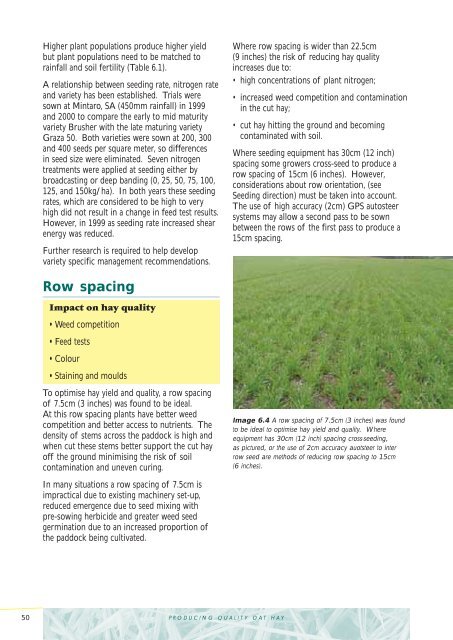You also want an ePaper? Increase the reach of your titles
YUMPU automatically turns print PDFs into web optimized ePapers that Google loves.
Higher plant populations produce higher yield<br />
but plant populations need to be matched to<br />
rainfall and soil fertility (Table 6.1).<br />
A relationship between seeding rate, nitrogen rate<br />
and variety has been established. Trials were<br />
sown at Mintaro, SA (450mm rainfall) in 1999<br />
and 2000 to compare the early to mid maturity<br />
variety Brusher with the late maturing variety<br />
Graza 50. Both varieties were sown at 200, 300<br />
and 400 seeds per square meter, so differences<br />
in seed size were eliminated. Seven nitrogen<br />
treatments were applied at seeding either by<br />
broadcasting or deep banding (0, 25, 50, 75, 100,<br />
125, and 150kg/ha). In both years these seeding<br />
rates, which are considered to be high to very<br />
high did not result in a change in feed test results.<br />
However, in 1999 as seeding rate increased shear<br />
energy was reduced.<br />
Further research is required to help develop<br />
variety specific management recommendations.<br />
Row spacing<br />
Impact on hay quality<br />
• Weed competition<br />
• Feed tests<br />
• Colour<br />
• Staining and moulds<br />
To optimise hay yield and quality, a row spacing<br />
of 7.5cm (3 inches) was found to be ideal.<br />
At this row spacing plants have better weed<br />
competition and better access to nutrients. The<br />
density of stems across the paddock is high and<br />
when cut these stems better support the cut hay<br />
off the ground minimising the risk of soil<br />
contamination and uneven curing.<br />
In many situations a row spacing of 7.5cm is<br />
impractical due to existing machinery set-up,<br />
reduced emergence due to seed mixing with<br />
pre-sowing herbicide and greater weed seed<br />
germination due to an increased proportion of<br />
the paddock being cultivated.<br />
50 PRODUCING QUALITY OAT HAY<br />
Where row spacing is wider than 22.5cm<br />
(9 inches) the risk of reducing hay quality<br />
increases due to:<br />
• high concentrations of plant nitrogen;<br />
• increased weed competition and contamination<br />
in the cut hay;<br />
• cut hay hitting the ground and becoming<br />
contaminated with soil.<br />
Where seeding equipment has 30cm (12 inch)<br />
spacing some growers cross-seed to produce a<br />
row spacing of 15cm (6 inches). However,<br />
considerations about row orientation, (see<br />
Seeding direction) must be taken into account.<br />
The use of high accuracy (2cm) GPS autosteer<br />
systems may allow a second pass to be sown<br />
between the rows of the first pass to produce a<br />
15cm spacing.<br />
Image 6.4 A row spacing of 7.5cm (3 inches) was found<br />
to be ideal to optimise hay yield and quality. Where<br />
equipment has 30cm (12 inch) spacing cross-seeding,<br />
as pictured, or the use of 2cm accuracy auotsteer to inter<br />
row seed are methods of reducing row spacing to 15cm<br />
(6 inches).

















